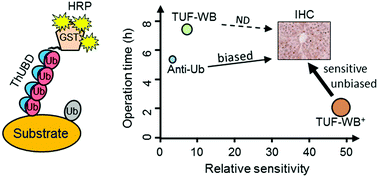Chemically labeled ThUBD permits rapid and super-sensitive imaging of polyubiquitination signals†
Abstract
Polyubiquitination signal deliver diverse cellular signal, which have been recognized as a sophisticated ubiquitin code. The perception and transduction of ubiquitination signal depend on the specificity and sensitivity of the ubiquitin-binding domain. Accurate and sensitive detection of polyubiquitination signal is crucial for revealing the dynamic cellular ubiquitin-regulated events. Western blotting (WB) and immunohistochemistry (IHC) are the most widely used biochemical strategies to detect ubiquitination signal on substrates under diverse physiological and pathological conditions. However, anti-ubiquitin antibodies fail to reflect polyubiquitination signal unbiasedly because of their strong preference for K63-linked ubiquitin chains. Herein, we demonstrated that our previously developed tandem hybrid ubiquitin-binding domain (ThUBD) chemically labeled with a reporter group such as horseradish peroxidase (ThUBD-HRP) could significantly improve the robustness and sensitivity of polyubiquitination signal detection. This advanced method was named TUF-WB Plus (TUF-WB+). The TUF-WB+ method significantly increases the sensitivity and accuracy of ubiquitin detection and requires a shorter experimental operation time. Furthermore, it enables the ThUBD-HRP probe to function as a powerful tool for spatial in situ polyubiquitination detection in cells by immunohistochemistry. Our newly developed ThUBD-HRP probe and TUF-WB+ method provide a robust and powerful tool for ubiquitination signal detection with hypersensitivity in an unbiased manner.

- This article is part of the themed collection: Analyst HOT Articles 2022


 Please wait while we load your content...
Please wait while we load your content...